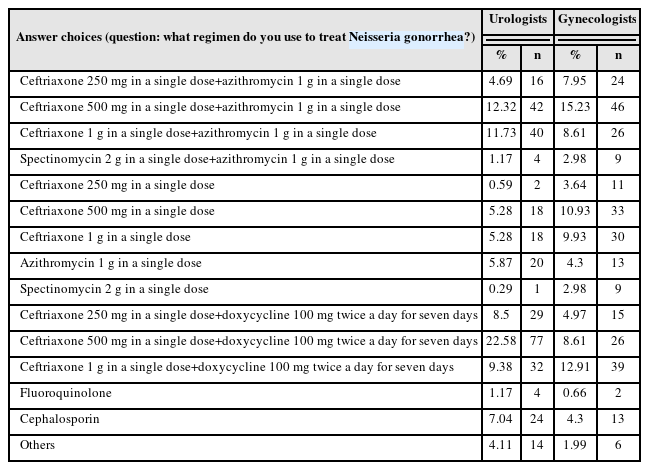Search
- Page Path
- HOME > Search
Original Articles
- Trend Analysis of Sexually Transmitted Infection Treatments in Korea
- Soeon Park, Byung Kyu Han, Sangrak Bae, Seung-Ju Lee, Jin Bong Choi
- Urogenit Tract Infect 2024;19(2):25-30. Published online August 31, 2024
- DOI: https://doi.org/10.14777/uti.2024.19.2.25

-
 Abstract
Abstract
 PDF
PDF PubReader
PubReader ePub
ePub - Purpose: The revision of the 2023 Guidelines for the Treatment of Sexually Transmitted Infections (STIs) has been released. Hence, it is necessary to analyze the current status of STI treatments in Korea.
Materials and Methods: A questionnaire was distributed to urologists and gynecologists from December 2022 to January 2023 through an online survey program. Three hundred and forty-one urologists and 302 gynecologists responded to the questionnaire.
Results: For Neisseria gonorrhea treatment, ceftriaxone 500 mg and 100 mg of doxycycline twice daily for seven days were most preferred by urologists (22.58%). The treatment most preferred by gynecologists (15.23%) was 500 mg of ceftriaxone and 1 g of azithromycin in a single dose. Both urologists and gynecologists generally treat Chlamydia trachomatis according to the treatment guidelines. For treating Mycoplasma genitalium, 29.03% of urologists preferred administering azithro-mycin at 500 mg once daily, followed by 250 mg for four days. In contrast, 33.11% of gynecologists preferred doxycycline 100 mg twice daily for seven days.
Conclusions: Most urologists and gynecologists followed the treatments recommended in the 2nd edition of the STI treatment guidelines, revised in 2016. As many treatment regimens have changed because of the recent increase in antibiotic-resistant STIs, there is a need to encourage them to follow the new treatment guidelines.
- 5,061 View
- 36 Download

- Syphilis Notification Systems in Korea over the Last 20 Years
- Yumi Seo, Gilho Lee
- Urogenit Tract Infect 2021;16(1):16-23. Published online April 30, 2021
- DOI: https://doi.org/10.14777/uti.2021.16.1.16
-
 Abstract
Abstract
 PDF
PDF Supplementary Material
Supplementary Material PubReader
PubReader ePub
ePub - Purpose: The syphilis notification system has been revised three times in Korea during the last 20 years. Accordingly, we evaluated the performance of the three systems by analyzing data from the Korea Disease Control and Prevention Agency (KDCA).
Materials and Methods: We analyzed trends of stage 1, 2, and congenital syphilis cases reported in the KDCA from 2001 to 2010 in the 1st sentinel (S1), from 2011 to 2019 in the 1st universal (U1), and 2020 in the 2nd sentinel (S2) notification system.
Results: A total of 21,820 syphilis cases were reported, 9,177 cases in S1, 12,321 in U1, and 322 in S2, respectively. The reported cases can be presented in the form of four expanding waves across the time period. Although the most commonly reported age group with infection was 20-29 years in all three reporting systems, the pattern of infections was different; the number of older patients was relatively high in the S1 group while the number of syphilis cases declined sharply in the older than 20-29 old age group in the U1 and S2 systems. Also, there was a sex-based difference in the three groups; the data from S1 were female-dominant but the data in U1 and S2 were male-dominant.
Conclusions: Our results showed that the universal notification system (U1) is superior in both the quantity and quality of data to the previous sentinel system (S1). The results from the new system, S2, are similar to those from U1. -
Citations
Citations to this article as recorded by- A Narrative Review of Syphilis Notification Systems in Korea: Change to Mandatory Surveillance System
Seung-Ju Lee, Jin Bong Choi
Urogenital Tract Infection.2025; 20(1): 28. CrossRef - Recent Changes in Sexually Transmitted Infection in Korea: A Population-Based Analysis
Jae Yen Song, Kang Seob Kim, Chang Hee Han, Sangrak Bae
Journal of Clinical Medicine.2025; 14(14): 5145. CrossRef - Rectal Syphilis Mimicking Malignancy: A Case Report
Sunjin Ryu, Bo-Kyeong Kang, Mimi Kim, Chul-Min Lee
Journal of the Korean Society of Radiology.2024; 85(3): 637. CrossRef - Temporal Trends in Syphilis Incidence among Men with HIV in Busan, Korea, 2005–2022: A Retrospective Cohort Study
Sun Hee Lee, Jeong Eun Lee, Soon Ok Lee, Shinwon Lee, Woo Seog Ko, Hyung-Hoi Kim, Kyung-Hwa Shin, Jin Suk Kang, Hyunjin Son
Viruses.2024; 16(2): 265. CrossRef
- A Narrative Review of Syphilis Notification Systems in Korea: Change to Mandatory Surveillance System
- 1,910 View
- 9 Download
- 4 Crossref


 KAUTII
KAUTII

 First
First Prev
Prev


